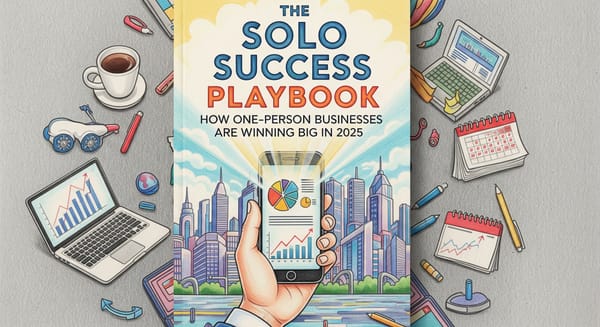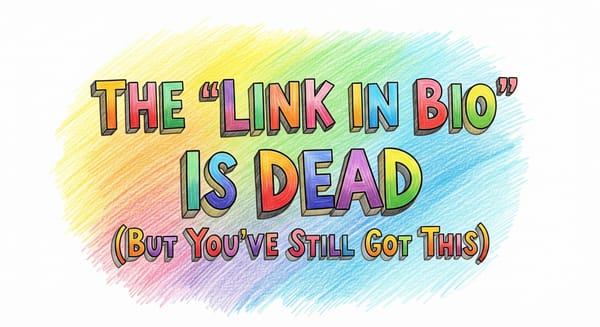Simple Marketing Tactics That Actually Work (and Don't Break the Bank)

Every time I open my inbox, I'm bombarded with ads about the "latest marketing software" or "revolutionary platform" that'll magically transform my business. The price tag? Usually enough to make my credit card weep.
But here's what 25+ years of building businesses has taught me: the most effective marketing rarely requires the biggest budget.
In fact, some of the most powerful tactics I've used cost next to nothing. Let me show you how to grow your business without emptying your wallet.
The Power of Human Connection
• Talk to actual humans (revolutionary, I know)
The simplest marketing tactic that most business owners overlook? Actually talking to their customers. Not through automated systems or chatbots, but genuine conversations.
True story: When I launched my third online business, I personally emailed the first 50 customers to ask why they bought from me. The insights I gained shaped my marketing for the next two years and cost me exactly zero dollars. Just an hour of my time and the courage to ask.
Try this: After someone buys from you, send them a personal email (not automated) asking what made them choose you. You'll be shocked at what you learn.
• Build community before selling
Most businesses try to sell immediately. Smart businesses build relationships first.
I've seen local bakeries outperform chain stores simply by remembering customers' names and favorite orders. I've watched tiny online stores thrive because they created Facebook groups where customers share their experiences.
The magic happens when people feel like they belong to something, not just that they're buying something.

Leverage What You Already Have
• Your existing customers are gold mines
The costliest mistake in business? Constantly chasing new customers while ignoring the ones you already have.
Here's a simple math lesson: It costs 5-7 times more to acquire a new customer than to keep an existing one. Yet most businesses spend 80% of their marketing budget on acquisition.
Try this instead: Create a simple referral program. When a customer refers a friend, both get something valuable. I've seen businesses double their customer base in months with this approach alone.
• Email marketing still works (when done right)
Despite what the social media gurus tell you, email remains the highest ROI marketing channel. Period.
But there's a catch: your emails need to be worth opening.
One of my clients was sending standard "10% off" promotional emails with dismal results. We switched to sending helpful tips with personality, with offers subtly woven in. Open rates jumped from 12% to 41% in two weeks.
The key? Value first, promotion second.
Free (Or Nearly Free) Traffic Generators
• Leverage local media (they need content as much as you need exposure)
Local newspapers, podcasts, and radio shows constantly need fresh content and interesting stories. You'd be amazed how easy it is to get featured if you approach them correctly.
When I opened my fourth business, I sent a simple press release to three local publications with an interesting angle about why I started. Two ran the story, and one interviewed me. Cost: one hour writing the release. Result: thousands in free publicity.
• Content that works while you sleep
Creating helpful content that answers your customers' questions is marketing that works 24/7.
A landscaping client of mine wrote 10 simple articles answering the most common questions his customers asked. Within six months, these articles were bringing in 30% of his new business leads – without spending a penny on ads.
The magic formula? Answer real questions people are asking + optimize for search engines + be genuinely helpful = free traffic forever.

Social Media That Actually Converts
• Behind-the-scenes content builds trust
People don't just buy products anymore; they buy stories and connection.
Show the humans behind your business. The messy office. The late-night packaging sessions. The mistakes and the victories.
One of my e-commerce clients started posting simple smartphone videos of their packaging process. No fancy editing, just authentic content. Their engagement rate tripled, and customers started mentioning these videos when ordering.
• Use social proof strategically
We all know testimonials matter, but most businesses use them wrong.
Don't just collect generic "great service!" reviews. Instead, ask customers specific questions like "What was your biggest concern before buying?" and "What specific result did you get?"
Then use these detailed testimonials exactly where customers experience those same concerns in your marketing. This approach addresses objections before they even form.
Guerrilla Marketing in the Digital Age
• Partner with complementary businesses
One of the fastest ways to grow is by leveraging someone else's audience – ethically, of course.
Look for businesses that serve the same customers as you but don't compete directly. A wedding photographer partnering with a florist. A fitness coach collaborating with a nutrition store.
I helped a client who sells handmade jewelry partner with a local boutique clothing store. They created a simple "style guide" together that the clothing store gave to customers, featuring the jewelry. Both businesses saw sales increase by 23% in three months.
The cost? Just the time to build the relationship and create the guide.
• Turn your customers into marketers
Give customers a reason (and the tools) to share their experience with your business.
A simple example: A restaurant client created an "Instagram corner" with good lighting and a fun backdrop. They added a small sign with their hashtag. User-generated content increased by 218% in the first month.

The Psychology of Small Wins
• Limited-time offers that actually make sense
Scarcity works, but fake scarcity damages trust. The key is creating genuine reasons for limited-time offers.
Instead of random discounts, tie promotions to meaningful events. A client who sells eco-friendly products runs special offers on Earth Day. Another does "founder's birthday" specials.
These make logical sense to customers and give you a genuine reason to create urgency.
• The power of unexpected delight
The best marketing often happens after the sale. When you exceed expectations, customers can't help but talk about you.
I always include a handwritten note with orders from my own businesses. It takes 30 seconds to write but generates incredible goodwill. One client adds a small, unexpected free gift with every purchase.
These tiny touches cost almost nothing but create word-of-mouth marketing you can't buy at any price.
Measure What Matters
• Track your results religiously
The biggest advantage small businesses have over larger competitors? The ability to adjust quickly based on results.
Set up simple tracking for every marketing tactic you try. It doesn't need to be complicated – even a basic spreadsheet works. Track where new customers come from and which channels produce the best ROI.
A coaching client discovered that while Instagram brought the most traffic to her site, email marketing generated 4x more sales. She adjusted her strategy accordingly and doubled her revenue within a quarter.
The Bottom Line
Effective marketing isn't about having the biggest budget – it's about being smarter with the resources you have.
The tactics I've shared cost little to nothing but require something many businesses aren't willing to give: time, creativity, and genuine care for your customers.
That's the real secret. The businesses that truly care about solving problems for their customers rarely struggle with marketing. When you provide remarkable value and genuine connection, your customers become your marketing department.
So before you invest in that expensive marketing platform or hire that pricey consultant, try these proven, low-cost tactics. You might discover that your best marketing tool isn't a tool at all – it's you and the value you provide.
Want more practical business advice that actually works in the real world? Check out my success stories from entrepreneurs who've built thriving businesses with simple, accessible strategies.
Remember: The simplest ideas often make the biggest money.



